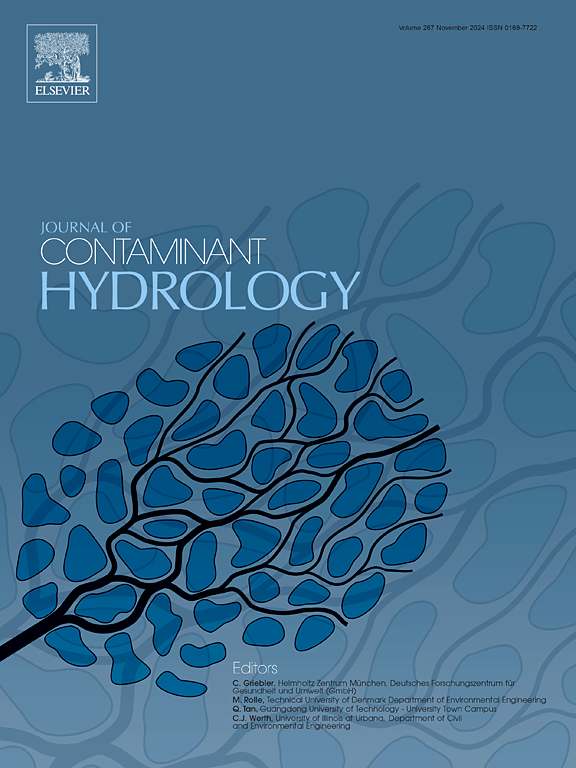Comparison of Ni (II) ion biosorption onto Eupatorium Adinophorum and Acer Oblongum biomass using batch operations, response surface models, thermodynamics, kinetics, and equilibrium studies
IF 4.4
3区 环境科学与生态学
Q2 ENVIRONMENTAL SCIENCES
引用次数: 0
Abstract
The batch operations, analysis of variance (ANOVA), and response surface quadratic models (RSM) were carried out for the biosorption of Ni(II) from synthetic aqueous solution onto treated Eupatorium adinophorum (AEA) and Acer oblongum (AAO) biomass. The impact of Ni-ion concentration, pH, adsorbent dose, contact time, and reaction temperatures was investigated. The maximum removal efficiency of the Ni(II) ion onto AEA and AAO biosorbent was 87.88 % and 91.1 %, respectively, at pH 5. The biosorption capacities for AEA and AAO biomass were determined to be 33.84 mg/g and 34.42 mg/g, respectively. The analysis of the morphology and the functional group of AEA and AAO was performed by scanning electron microscopy (SEM), Energy Dispersive X-ray Spectroscopy (EDS), and Fourier transform infrared (FTIR) spectroscopy. Ni(II) ion biosorption was endothermic, spontaneous, and viable thermodynamically. The three adsorption isotherms, Freundlich, Dubinin-Radushkevich (D-R), and Langmuir, shows that the Langmuir model best matches the data, with regression coefficient values (Adj. R2) of more than 0.99. The kinetic model demonstrated the biosorption via a chemisorption mechanism and gave the best correlation with pseudo-second-order kinetics. The findings showed that both biomass residues have the potential to be employed as inexpensive biosorbents, but AAO has a higher ability than AEA to remove Ni(II) from wastewater.

利用间歇操作、响应面模型、热力学、动力学和平衡研究比较Adinophorum和Acer Oblongum对Ni (II)离子的生物吸附
采用批量操作、方差分析(ANOVA)和响应面二次模型(RSM)对合成水溶液中Ni(II)在处理过的紫茎泽兰(AEA)和长叶槭(AAO)生物量上的吸附进行了研究。考察了ni离子浓度、pH、吸附剂剂量、接触时间、反应温度等因素的影响。在pH为5的条件下,AEA和AAO对Ni(II)离子的最大去除率分别为87.88%和91.1%。测定其对AEA和AAO的吸附量分别为33.84 mg/g和34.42 mg/g。采用扫描电镜(SEM)、x射线能谱(EDS)和傅里叶变换红外光谱(FTIR)对AEA和AAO的形貌和官能团进行了分析。Ni(II)离子的生物吸附是吸热的、自发的和热力学上可行的。Freundlich、Dubinin-Radushkevich (D-R)和Langmuir三条吸附等温线的回归系数(Adj. R2)均大于0.99,表明Langmuir模型与数据吻合最好。动力学模型证明了生物吸附是通过化学吸附机理进行的,并给出了与拟二级动力学的最佳相关性。研究结果表明,这两种生物质残渣都有潜力作为廉价的生物吸附剂,但AAO对废水中Ni(II)的去除能力高于AEA。
本文章由计算机程序翻译,如有差异,请以英文原文为准。
求助全文
约1分钟内获得全文
求助全文
来源期刊

Journal of contaminant hydrology
环境科学-地球科学综合
CiteScore
6.80
自引率
2.80%
发文量
129
审稿时长
68 days
期刊介绍:
The Journal of Contaminant Hydrology is an international journal publishing scientific articles pertaining to the contamination of subsurface water resources. Emphasis is placed on investigations of the physical, chemical, and biological processes influencing the behavior and fate of organic and inorganic contaminants in the unsaturated (vadose) and saturated (groundwater) zones, as well as at groundwater-surface water interfaces. The ecological impacts of contaminants transported both from and to aquifers are of interest. Articles on contamination of surface water only, without a link to groundwater, are out of the scope. Broad latitude is allowed in identifying contaminants of interest, and include legacy and emerging pollutants, nutrients, nanoparticles, pathogenic microorganisms (e.g., bacteria, viruses, protozoa), microplastics, and various constituents associated with energy production (e.g., methane, carbon dioxide, hydrogen sulfide).
The journal''s scope embraces a wide range of topics including: experimental investigations of contaminant sorption, diffusion, transformation, volatilization and transport in the surface and subsurface; characterization of soil and aquifer properties only as they influence contaminant behavior; development and testing of mathematical models of contaminant behaviour; innovative techniques for restoration of contaminated sites; development of new tools or techniques for monitoring the extent of soil and groundwater contamination; transformation of contaminants in the hyporheic zone; effects of contaminants traversing the hyporheic zone on surface water and groundwater ecosystems; subsurface carbon sequestration and/or turnover; and migration of fluids associated with energy production into groundwater.
 求助内容:
求助内容: 应助结果提醒方式:
应助结果提醒方式:


